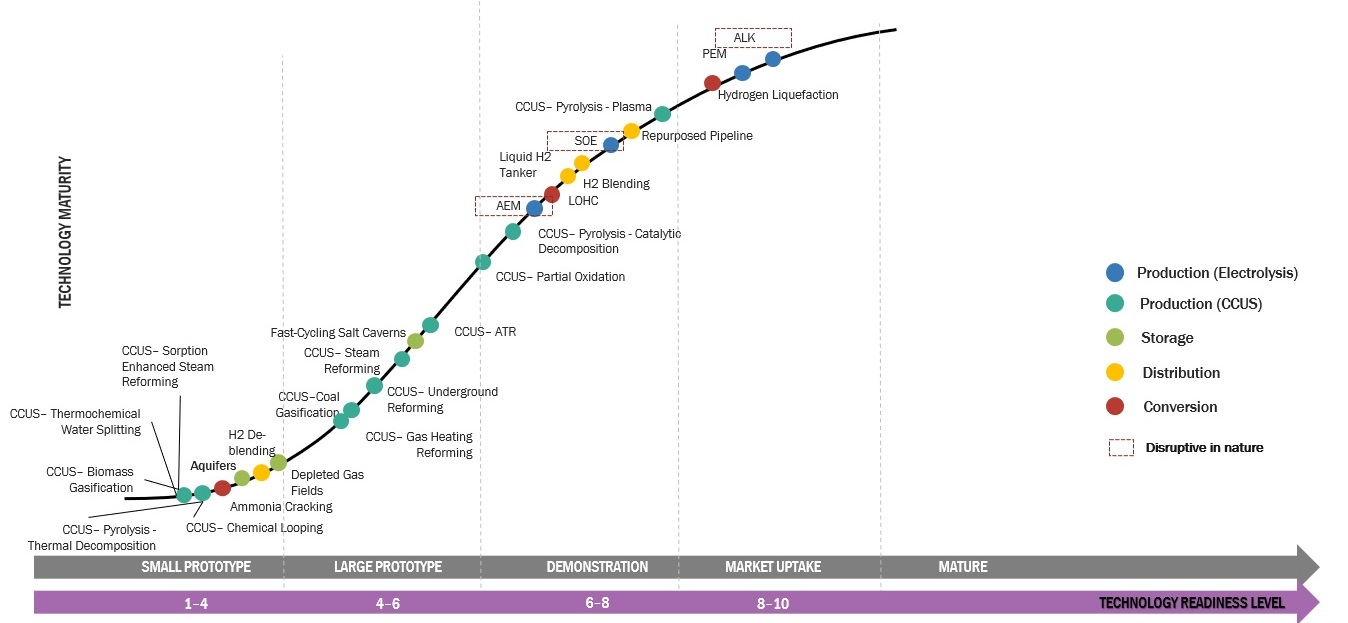Hydrogen Technologies

Hydrogen is a clean, adaptable energy source that has a wide range of uses. These are some of the most widely utilized hydrogen technologies, along with a comparison of the benefits and drawbacks of each:
Download – https://www.marketsandmarkets.com/industry-practice/RequestForm.asp
- Steam Methane Reforming (SMR): Approximately 95% of hydrogen produced worldwide is produced via SMR, the most widely used technology. In the presence of a catalyst, methane and steam are reacted to form carbon dioxide and hydrogen. SMR is a well-established technology that is reasonably priced, effective, and produces carbon dioxide as a byproduct—a factor in climate change.
- Electrolysis: Water may be split into hydrogen and oxygen using an electrical process called electrolysis. Both alkaline and proton exchange membrane (PEM) electrolysis are forms of the process. Though less effective than PEM electrolysis, alkaline electrolysis is a well-established technology and is reasonably priced. More recent and more expensive than alkaline electrolysis, PEM electrolysis is a more effective method. Although producing hydrogen carbon-free by electrolysis calls for a large amount of electricity, which can originate from non-renewable sources, it is nevertheless possible.
- Biomass Gasification: The process of biomass gasification entails heating organic materials—like wood or agricultural waste—without the presence of oxygen in order to create a gas that can be refined into hydrogen. Although biomass gasification is a renewable and carbon neutral technique of producing hydrogen, it is not cheap and needs a large volume of biomass fuel.
- Nuclear: Water is divided using high-temperature nuclear reactors in the nuclear hydrogen generation process. Though costly and raising questions about the security and safety of nuclear reactors, this technology produces hydrogen without emitting carbon.
- Photobiological: Hydrogen is produced through the process of photobiological hydrogen production, which makes use of photosynthetic microbes or algae. The development of this technique to produce hydrogen is still ongoing, but it has the potential to be carbon neutral and renewable.
- Solid Oxide Electrolysis Cells (SOEC): In SOECs, water is divided into hydrogen and oxygen using a ceramic electrolyte. Although this technology is still in the research and development stage, it is effective.
- Thermochemical: Thermochemical hydrogen production is the process of generating hydrogen from fossil fuels or other sources by means of chemical processes and heat. Although this technique is currently in the research and development stage, it has the potential to be carbon neutral.
Explanation of Hydrogen Technologies
Technology and procedures related to the creation, distribution, storage, and use of hydrogen as an energy source are collectively referred to as hydrogen technologies. Energy needs can be met while reducing environmental impact by utilizing hydrogen, the most plentiful element in the universe, in a variety of forms.
Green Hydrogen Systems
Green Hydrogen Systems are defined as the technology, infrastructure, and procedures used to produce, store, and use hydrogen with the least amount of negative environmental impact possible while utilizing renewable energy sources. In this context, the term “green” refers to how ecologically benign the process of producing hydrogen is.
Greenhouse gas emissions are produced during conventional hydrogen generation processes like coal gasification and steam methane reforming (SMR), which exacerbate climate change. Green hydrogen systems, on the other hand, seek to manufacture hydrogen by an electrolysis process using renewable energy sources, such as solar, wind, or hydropower.
Hydrogen (H₃) and oxygen (O₂) are produced during the electrolysis process by dividing water (H₂O) with electricity. Hydrogen is a cleaner and more sustainable energy source when its electricity is derived from renewable sources, as this lowers the hydrogen generation process’s overall carbon footprint. The use of green hydrogen is thought to be essential to the shift to an energy system that is low-carbon and ecologically friendly.
Hydrogen Fuel Technology
The term “Hydrogen Fuel Technology” describes the range of techniques and tools used in the creation, storing, and use of hydrogen as a fuel for energy-related purposes. Utilizing hydrogen as a fuel can help address environmental issues and reduce greenhouse gas emissions because it is seen as a flexible and clean energy source. The following are the main facets of hydrogen fuel technology:
- Production: There are several ways to manufacture hydrogen, such as electrolysis, biomass gasification, and natural gas reforming. It’s commonly called “green hydrogen” when the production process uses renewable energy sources, including solar or wind power.
- Storage: The low density of hydrogen means that efficient storage techniques are needed, despite its large energy content. Advanced materials such as metal hydrides and liquid and compressed hydrogen gas are common storage alternatives.
- Transportation: Transporting hydrogen for use in a variety of industries, including industrial and transportation, is possible. The creation of hydrogen distribution infrastructure, such as pipelines, storage facilities, and hydrogen fuel cell vehicles for transportation, is required for this.
- Utilization: Fuel cells are one prominent application where hydrogen can be utilized as a fuel. Through an electrochemical mechanism, fuel cells transform hydrogen into energy, with the only waste being heat and water vapor. Internal combustion engines can also use hydrogen combustion.
- Integration with Renewable Energy: Since using power from renewable sources for the electrolysis process is a “green” part of producing hydrogen, hydrogen fuel technology and renewable energy sources frequently interact.
The progress and evolution of hydrogen fuel technology are essential elements in the endeavor to shift towards an energy system that is low-carbon and more sustainable. It presents viable answers to problems pertaining to transportation, energy storage, and the mitigation of greenhouse gas emissions.
Hydrogen Power Systems
Systems that use hydrogen to create electricity are those that have the necessary infrastructure and technology in place to capture the energy released when hydrogen reacts with oxygen. Fuel cells are the most popular means of harnessing hydrogen in power systems.
Here is a summary of the main elements and procedures found in Hydrogen Power Systems:
- Fuel Cells: Fuel cells are devices that use an electrochemical reaction to transform the chemical energy contained in hydrogen into electrical energy. The proton exchange membrane fuel cell (PEMFC) is the most widely used kind of fuel cell. In a fuel cell, the cathode receives oxygen (often from the air) while the anode receives hydrogen. As byproducts of the electrochemical reactions, heat, water, and electricity are produced.
- Electrolysis: Electrolysis is a process that uses electricity to split water (H2O) into hydrogen (H₂) and oxygen (O₂), producing hydrogen for power systems. The hydrogen produced during electrolysis that is powered by renewable energy sources, such solar or wind power, is frequently referred to as “green hydrogen.”
- Hydrogen Storage: Power systems require effective hydrogen storage techniques. Compressed hydrogen gas, liquid hydrogen, and novel materials such metal hydrides are common forms of storage.
- Power Generation: Applications for hydrogen power systems are numerous and include both fixed power generation for buildings and industrial facilities and mobile uses, such as hydrogen fuel cell cars.
- Combined Heat and Power (CHP): Condensed heat and power, or cogeneration, is the term for systems that use hydrogen to produce both electricity and heat. The utilization of heat generated as a byproduct during the electricity generation process improves overall energy efficiency.
Hydrogen power systems are a viable option for industries where direct electrification may be difficult, and they are crucial to the shift to greener and more sustainable energy sources. They are especially important for applications that call for longer-term energy storage and high energy density.
Hydrogen Vehicle Technology
The creation and application of hydrogen-powered vehicles, usually via fuel cell technology, is known as Hydrogen Vehicle Technology. Vehicles using hydrogen engines provide an alternative to those with conventional internal combustion engines and battery-electric vehicles. The following are the main elements and characteristics of hydrogen car technology:
- Fuel Cells: Fuel cells are used in hydrogen fuel cell vehicles (FCVs) to electrochemically transform hydrogen gas into energy. Three essential components make up a fuel cell: a proton exchange membrane, a cathode, and an anode. The only emission is water vapor, which is produced when hydrogen and oxygen mix to provide electricity for the car’s electric motor.
- Hydrogen Storage: High-pressure tanks within the vehicle are used to store hydrogen. Liquid hydrogen and compressed hydrogen gas are two types of storage systems. For hydrogen vehicles to be practical and have a reasonable range, effective and safe storage is essential.
- Electric Drive System: The fuel cell generates electricity that powers an electric motor, which gives the car propulsion. In terms of the electric drivetrain, hydrogen fuel cell vehicles function similarly to battery electric vehicles.
- Refueling Infrastructure: Fueling hydrogen-powered vehicles necessitates a specialized infrastructure. To accommodate the expanding fleets of hydrogen-powered vehicles, hydrogen refueling stations are being built throughout the world.
- Advantages:
- Zero Emissions: Hydrogen fuel cell vehicles are an eco-friendly and clean mode of transportation because their only output is water vapor.
- Quick Refueling: For some users, filling a hydrogen vehicle is more convenient than charging an electric vehicle because it takes about the same amount of time.
- Long Range: Hydrogen cars are appropriate for applications requiring lengthy travel distances since they can attain extensive driving ranges on a single hydrogen tank.
- Challenges:
- Infrastructure Development: When it comes to traditional gasoline or electric charging stations, hydrogen refueling infrastructure is currently less readily available.
- Production Challenges: The manufacture of hydrogen can include energy-intensive procedures, therefore the deployment of sustainable hydrogen vehicles aims to produce “green hydrogen” from renewable energy sources.
- Cost: Because of the high cost of hydrogen storage and fuel cell technology, hydrogen fuel cell vehicles can be more expensive than conventional internal combustion engine automobiles.
The development of hydrogen vehicle technology is thought to be a viable means of reaching zero-emission mobility, especially in scenarios requiring rapid and long-range recharging, as in heavy-duty transportation and specific fleet types. The goal of current research and technological developments is to solve obstacles and encourage the broader use of hydrogen-powered cars.
New Hydrogen Technology
The most recent and cutting-edge developments in the fields of hydrogen generation, storage, transportation, and utilization are referred to as “New Hydrogen Technology“. The hydrogen value chain as a whole may be innovated, as well as fuel cell and electrolysis technique developments and new materials for hydrogen storage. With a focus on lowering environmental effects and raising efficiency, the phrase is frequently used in reference to initiatives aimed at transforming hydrogen into a more economically and environmentally feasible energy source.
Key areas of interest in new hydrogen technology may involve:
- Green Hydrogen Production: methods for producing hydrogen that make use of renewable energy sources, including electrolysis using solar or wind power, which produces “green hydrogen.”
- Advanced Storage Solutions: New storage technologies and advancements in materials science are examples of innovations in hydrogen storage systems that are intended to increase safety and efficiency.
- Transportation Infrastructure: Innovations in the infrastructure required for hydrogen production, delivery, and recharging, such as the growth of hydrogen refueling stations.
- Hydrogen Utilization: Increases in hydrogen’s effectiveness and suitability for use in a variety of industries and sectors, including power production, transportation, and industrial.
- Cost Reduction: Attempts to lower the total cost of hydrogen production, storage, and consumption in order to increase the economic viability of hydrogen technologies.
It’s crucial to remember that the field of hydrogen technology is dynamic and that new and improved technologies are constantly being developed as a result of ongoing research and development. It is advised to review recent scientific publications, business reports, and news sources for the most up-to-date details on novel hydrogen technology.
Read More – https://www.marketsandmarkets.com/industry-practice/hydrogen/hydrogen-technologies-comparison






